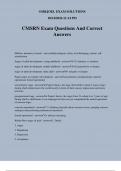©SIRJOEL EXAM SOLUTIONS
10/14/2024 11:14 PM
CMSRN Exam Questions And Correct
Answers
Mallows hierarchy of needs - answer✔physiological, safety, love/belonging, esteem, self-
actualization
Stages of adult development: young adulthood - answer✔18-35, intimacy vs isolation
stages of adult development: middle adulthood - answer✔36-65 generativity vs despair
stages of adult development: older adult - answer✔66+ integrity vs despair
Piaget stages of cognitive development - answer✔sensorimotor, preoperational, concrete
operational, formal operational
sensorimotor stage - answer✔in Piaget's theory, the stage (from birth to about 2 years of age)
during which infants know the world mostly in terms of their sensory impressions and motor
activities
preoperational stage - answer✔in Piaget's theory, the stage (from 2 to about 6 or 7 years of age)
during which a child learns to use language but does not yet comprehend the mental operations
of concrete logic.
concrete operational - answer✔7-11 thinking logically about concrete events; grasping concrete
analogies and performing arithmetical operations
formal operational - answer✔12+ abstract reasoning
Kubler-Ross stages of grief - answer✔1. Denial
2. Anger
3. Bargaining
4. Depression
5. Acceptance
, ©SIRJOEL EXAM SOLUTIONS
10/14/2024 11:14 PM
Pattison living dying theory - answer✔begins when person learns they are dying and end at the
actual time of death
corr death and dying - answer✔created task based model of death and dying. focused on how
people cope with dying by completing physical, psychosocial, social, and spiritual tasks
Doka phases of death and dying - answer✔phase based model in response to death and dying.
prediagnostic, acute, chronic, terminal, and recovery phases of life threatening illnesses.
Leadership Styles - answer✔authoritarian, democratic, laissez-faire, transformational, servant
Leadership Styles: Democratic - answer✔The managers encourages employee participation in
decisions, works with them to determine what to do, and doesn't supervise them closely- Theory
Y behavior
Leadership Styles: Laissez-faire - answer✔There is no focus in this type of leadership.
Goals are undefined, and members do as they please.
Productivity and morale are low.
Negligence - answer✔careless neglect, often resulting in injury
Malpractice (professional negligence) - answer✔Failure of a person with professional training to
act in a reasonable and prudent manner. requires proof of duty, breach of duty, and
damages/harm.
intentional tort - answer✔Assault and battery
Defamation of character
Invasion of privacy
False imprisonment
Fraud
Deontology - answer✔Approach to ethics that judges the morality of an action based on the
action's adherence to rules. Described as duty or obligation, because rules 'binds you to your
duty'
Utilitarianism - answer✔The theory, proposed by Jeremy Bentham in the late 1700s, that
government actions are useful only if they promote the greatest good for the greatest number of
people.
Beneficence - answer✔Doing good or causing good to be done; kindly action
, ©SIRJOEL EXAM SOLUTIONS
10/14/2024 11:14 PM
Nonmaleficence - answer✔duty to do no harm
Justice - answer✔fairness; rightfulness
veracity - answer✔truthfulness
fidelity - answer✔faithfulness; loyalty
Bandura's Social Learning Theory - answer✔Learning occurs when we observe other people and
model their behavior
Health Belief Model (HBM) - answer✔a non-stage theory that identifies three beliefs that
influence decision making regarding health behavior: perceived susceptibility to a health threat,
perceived severity of the disease or condition, and perceived benefits of and barriers to the
behavior
Kurt Lewin's Change Model - answer✔1. Unfreezing: create awareness of need for change
2. Changing: implement change
3. Refreezing: reinforce, stabilize, solidify
healthy people 2020 - answer✔1. Identify nationwide health improvement priorities.
2. Increase public awareness and understanding of the determinants of health, disease, and
disability and the opportunities for progress.
3. Provide measurable objectives and goals that are applicable at the national, State, and local
levels.
4. Engage multiple sectors to take actions to strengthen policies and improve practices that are
driven by the best available evidence and knowledge.
5. Identify critical research, evaluation, and data collection needs.
NIC/NOC - answer✔-Nursing interventions Classification and Nursing Outcomes Classification
-standardized language for nursing treatments for practice and research
-Developed at U Iowa
compartment syndrome - answer✔involves the compression of nerves and blood vessels due to
swelling within the enclosed space created by the fascia that separates groups of muscles
post op care - answer✔initial postoperative care focuses on careful assessment and immediate
intervention for cardiopulmonary complications, thrombus formation, anastomosis leaks, and
electrolyte imbalances




